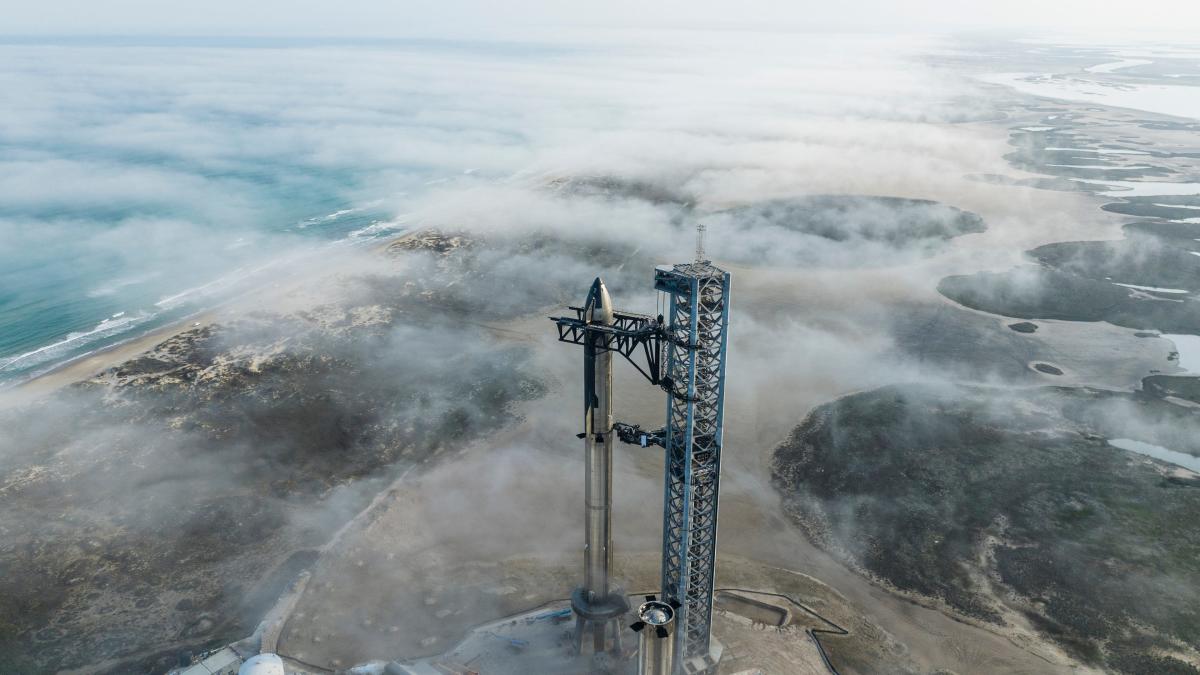Global Courant 2023-04-20 20:03:39
Already towering over the low-lying southern tip of Texas, SpaceX’s spacecraft gained even more altitude early Thursday when it launched its first integrated test, making it the most powerful rocket in history.
But the rocket also met a fiery end shortly after launch at 9:33 a.m. EDT from the company’s Starbase area of operations near Brownsville, Texas.
Just over three minutes into the flight over the Gulf of Mexico, it became apparent that the first stage Super Heavy booster and second stage spacecraft would not separate as planned, causing the combined 400-foot stack to collapse into a fall . It eventually broke apart and crashed into the Gulf.
Aside from the separation error, three of the 33 Raptor engines also failed to ignite on launch.
Despite the hardware problems, Elon Musk’s company SpaceX considers the mission largely a success — teams initially hoped to see the rocket’s engines ignite and then clear the tower. Everything else meant additional data for engineers to review.
“From a milestone point of view, our main goal is to clear the path (which means ascending past the 500-foot launch tower without failing),” Kate Tice, a SpaceX engineering manager, said during the launch webcast. “Every milestone after that is a bonus. The further we fly, the more data we collect.”
Earlier: SpaceX scrubs launch of Starship’s first integrated test flight from Texas
Meet the SpaceX starship: It is bigger and more powerful than Artemis SLS. But will it fly?
If all had gone according to plan, Starship would have cleared the tower and then flown over the Gulf of Mexico. Just before the three minute mark, Starship and Super Heavy would have separated and the latter would have attempted a landing in soft water. Starship would have continued to reach an altitude of about 150 miles before making an attempt to land itself in soft water near Hawaii.
A previous attempt to launch Starship earlier this week was scrubbed due to technical problems with a frozen valve in the Super Heavy booster, but technicians were able to fix the problem quickly and turn the vehicle around for another attempt 72 hours later.
Story continues
Back at the Kennedy Space Center, meanwhile, the SpaceX teams are aiming for no earlier than Wednesday, April 26, for the next launch in Florida. A three-core Falcon Heavy rocket will fly that evening around 7:30 p.m. EDT, though timelines are not yet finalized. Neither the two side boosters nor the middle booster are recovered after launch, so no local sonic booms this time.
What is Starship?
Starship is SpaceX’s version of a next-generation launch system designed to deliver people, cargo and payloads to Earth, Moon and Mars orbit.
It’s likened to something out of science fiction thanks to its reflective, stainless steel outer shell.
The vehicle consists of two parts: Super Heavy, a huge booster equipped with 33 Raptor engines that will lift Starship, a 164-meter spacecraft capable of carrying people and cargo beyond low Earth orbit. It produces more thrust than the Apollo-era Saturn V rocket and NASA’s current Space Launch System.
To date, SpaceX is estimated to have spent at least several billion dollars on the Starship program.
SpaceX uses Starbase in Texas to prototype and build the first Starships. Low lying and close to the ocean, is the area as are Cape Canaveral and Kennedy Space Center, especially during the Apollo days. Before SpaceX, there was no aerospace industry there.
Why is Starship important?
Musk’s reason for committing to Starship and Super Heavy hinges on his belief that humanity must become one multi-planetary, spacefaring species rather now than never.
Musk envisions Starship as the vehicle that will help SpaceX fulfill its vision of putting human boots on Mars. He eventually wants hundreds of people to travel to the red planet in each spaceship.
NASA awarded SpaceX $2.9 billion last year specifically for Starship, which is proposed as the lunar lander for the agency’s Artemis program. If that architecture works, it will take the next set of US astronauts from lunar orbit to the surface of the moon during the Artemis III mission. The astronauts will use NASA’s Space Launch System rocket and Orion capsule to reach lunar orbit before docking with Starship, which will be waiting for them.
“As part of the (original) contract, SpaceX will also conduct an uncrewed demonstration mission to the Moon ahead of Artemis III,” NASA said late last year when it awarded SpaceX a second $1.15 Starship development contract. billion.
So far, the rocket has made only short sub-orbital test flights. An orbital flight is a big step toward preparing for that lunar mission expected sometime before 2030.
Design illustration of a SpaceX Starship human lander that will deliver NASA astronauts to the lunar surface during the Artemis mission.
Has Starship launched before?
Previous test flights, which often ended in explosions, have featured only the Starship vehicle itself, but this time the 400-foot combined vehicle is launching from Texas.
SpaceX began building the first stainless steel Starship prototype, known as “Starhopper”, in Texas, where it was successfully launched on a minute test flight at low altitude known as a “hop” in August 2019. A series of suborbital test flights were designed to stress systems and components to inform the production of larger prototypes.
In December 2020, the much larger Starship Serial Number 8 prototype was the first to successfully launch from Starbase. After launch, it sailed to a high-altitude suborbital apogee and briefly appeared to hover. Then it turned for a “belly flop” descent back to Earth. Although it exploded just short of its landing pad, all of SpaceX’s nuclear test objectives for that flight were met.
In February 2021, the Starship Serial Number 9 prototype took flight. The 165-foot vehicle launched for a short test and automatically throttled its Raptor engines at about 33,000 feet. It then performed the “belly flop” using adjustable fins to establish a trajectory back to the launch site. Although the test passed SpaceXThe SN9’s primary purpose was that it not fully tilt from “belly down” to an upright position, causing it to explode on impact.
During SpaceX’s third high-altitude Starship flight in March 2021, Starship Serial Number 10 successfully completed all targets and performed the first landing of the next-generation vehicle. But minutes after landing, the spacecraft unexpectedly exploded.
Starship Serial Number 15 was the first to launch, land and remain intact. In May 2021, SN15 took off from a concrete platform and ascended to an altitude of 10 kilometers or 33,000 feet, before using its “body” as an airbrake to descend back to the launch site. Just before touchdown, it spun around and landed softly under the power of two Raptor engines – a first for the program.
Contact Jamie Groh at JGroh@floridatoday.com and follow her Twitter at @AlteredJamie.
Please contact Emre Kelly at aekelly@floridatoday.com. Follow him on Twitter And Instagram at @EmreKelly.
This article originally appeared on Florida Today: SpaceX launch video: Starship rocket explodes, crashes after launch




